The Electronic Intifada 2 April 2021

A Palestinian woman reacts as Israeli forces demolish her home south of Yatta, near Hebron, in Area C — the 60 percent of the West Bank under full Israeli military control — on 2 March.
APA imagesIsraeli forces killed at least two Palestinians and injured several more during March. The month also saw a general election in Israel and the announcement of a war crimes investigation by the International Criminal Court.
Atef Yusef Hanaisheh, 45, was participating in a demonstration against settlement expansion in the occupied West Bank village of Beit Dajan, east of Nablus, on 19 March when he was shot in the head and killed by soldiers.
Residents of Beit Dajan have been holding weekly demonstrations after an Israeli settler set up an outpost on village land last September.
At least five Palestinians in the West Bank have been killed by Israeli fire so far this year.
Also in March, Israeli police shot and killed a Palestinian man reportedly experiencing a mental health crisis in Haifa. The family of the slain man, identified as 33-year-old Munir Anabtawi, had reportedly called the police asking for help.
“Police said they responded to a report of a man acting erratically,” the Associated Press reported. “In a statement, they said the man tried to stab them and lightly wounded one officer. The man was shot, taken to a hospital and pronounced dead.”
His family said he was shot five times in the confrontation.
On 24 March, a Palestinian laborer from the West Bank who lacked a permit to work in Israel died after falling into a shaft while being chased by Border Police at a construction site in Tel Aviv.
Kav LaOved, a workers’ defense group, said his death had been “unnecessary.”
“Officers are not allowed to chase the employee under these circumstances, especially since the worker didn’t pose a threat,” the group said.
Fishers killed in explosion
In Gaza, three Palestinians belonging to the same extended family were killed in an explosion on 7 March while fishing off of the coast.
Human rights groups attributed the explosion to nearby Palestinian resistance training activity. Gaza’s interior ministry said the fishers were killed after hauling an Israeli military drone in their nets.
The interior ministry said that “parts of an Israeli quadcopter drone that carried explosives were discovered” in the fishing boat’s nets, Reuters news agency reported. Israeli forces had attacked a Palestinian fishing boat off of Gaza’s waters on 22 February.
Israel denied responsibility for the explosion that killed the fishers.
Eleven Palestinian fishers have been killed off of Gaza’s coast since 2016 – six by the Israeli navy and two by Egyptian forces – according to the human rights group Al-Haq.
Al-Haq attributed the killing of the three fishers in March to “a drone strike by Palestinian armed groups during a training exercise.”
Israeli forces opened fire towards Gaza fishers multiple times during March.
On 5 March, two fishers were shot and injured after their “boat had malfunctioned and was pulled by currents towards the 6 nautical mile limit” imposed by Israel.
Al-Haq has called on the chief prosecutor of the International Criminal Court to “investigate individuals including corporate agents who have maintained the blockade and closure” of the Gaza Strip.
The ICC had opened a formal investigation into war crimes in the West Bank and Gaza Strip, chief prosecutor Fatou Bensouda announced on 3 March.
The specter of an indictment at The Hague did not deter Israeli lawmakers from openly admitting their intent to perpetrate war crimes in order to curry the West Bank settler vote on the eve of Israel’s general elections, held on 13 March.
The transfer of Israel’s civilian population into occupied territory is a violation of international law and a war crime.
Israeli Prime Minister Benjamin Netanyahu’s right-wing alliance failed to win an overall majority at the polls – the fourth election in two years.
“Vaccine apartheid”
Palestinians living in the same territory as Israeli settlers are unable to vote in the elections of the state that rules over them.
Nor are they eligible to receive the vaccines provided by Israel to its civilian population living in the West Bank.
Israel’s “vaccine apartheid” was also discussed during a parallel event to the UN Human Rights Council’s 46th session in March.
“The disparity in access to vaccines – with Palestinians having very little access and Israel leading the world in vaccine coverage – is a direct result of the apartheid and colonial aspects that characterize its occupation,” Nuriya Oswald, an international law expert with the Gaza-based rights group Al Mezan, stated.
As the occupying power, Israel is obliged by international law to provide inoculations to the 5 million Palestinians living under its military rule.
Israel did begin providing vaccines to more than 100,000 Palestinians who work in its factories and construction sites and inside its settlements.
Omar Shakir, a program director at Human Rights Watch, observed that “vaccinating only those Palestinians who come in contact with Israelis reinforces that, to Israeli authorities, Palestinian life only matters to the extent it affects Jewish life.”
Six Israeli and Palestinian human rights groups petitioned Israel’s high court during March, demanding that the state ensure the provision of vaccine doses to Palestinians in the West Bank and Gaza.
At the close of the month, the International Committee of the Red Cross warned that there was a near-25 percent positivity rate of COVID-19 in Gaza. “There are only enough vaccines for a few thousand people,” the group said.
As of 25 March, fewer than 30,000 Palestinians had been vaccinated in the West Bank and Gaza.
There were around 24,500 active cases of COVID-19 in those territories as of 30 March.
Nearly 2,900 Palestinians in the West Bank and Gaza have died from the disease so far.
“The most vulnerable people”
Philippe Lazzarini, the head of UNRWA, the UN agency for Palestine refugees, said that 45,000 Palestinian refugees who fled Syria to Jordan and Lebanon are “amongst the most vulnerable people as both countries struggle with the impact of COVID-19.”
More than half of the Palestinian refugee population in Syria was displaced at least once during the conflict that engulfed the country following the protests that began there 10 years ago this March.
There were more than 550,000 Palestinian refugees in Syria before the war. Some 120,000 have fled the country, mainly to Lebanon and Jordan.
A decade after the outbreak of armed conflict in Syria, “some 600 families have recently returned to Yarmouk camp,” Lazzarini stated.
That camp – long considered the capital of the Palestinian refugee diaspora – lies in ruins after years of siege and fighting for control over the southern gateway to Damascus.
Lazzarini meanwhile called for funding to rebuild homes destroyed in northern Lebanon’s Nahr al-Bared refugee camp in 2007.
Palestinians displaced by fighting between insurgent armed groups and the Lebanese army are still living in “unsanitary temporary shelters” and are still waiting for “decent housing [more than] 14 years after losing their homes,” Lazzarini said.
This article was updated after publication to correct the spelling of Munir Anabtawi’s first name.

Tens of thousands of Palestinians with Israeli citizenship march in the city of Umm al-Fahm to protest against Israeli police violence and organized crime on 5 March. The previous week Israeli police attacked protesters by shooting tear gas and sponge bullets.
ActiveStills
Residents of the Italian tower, a residential building destroyed in an Israeli airstrike in 2014, protest in front of the housing ministry in Gaza City on 5 March, calling for a return to their homes.
APA images
An Israeli soldier records the demolition of a Palestinian house near Hebron on 8 March on the pretext that it was being built without a permit. Israel almost never grants building permits to Palestinians in Area C, the some 60 percent of the West Bank under full military control.
APA images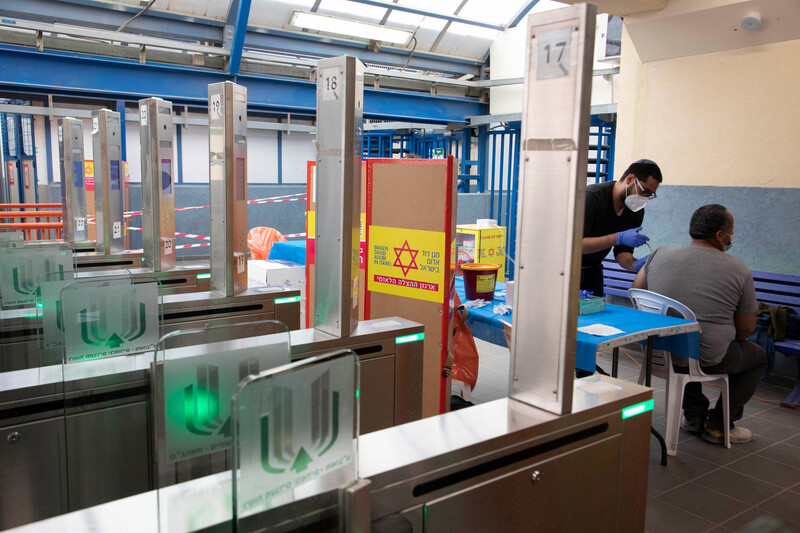
A Palestinian laborer who works in Israel receives a COVID-19 vaccine at an Israeli military checkpoint south of the West Bank city of Hebron on 8 March. While spurning its obligations to provide inoculations to Palestinians living under its military occupation, Israel launched a campaign to vaccinate some 100,000 Palestinians in the West Bank who hold permits to work in settlements and inside Israel.
ActiveStills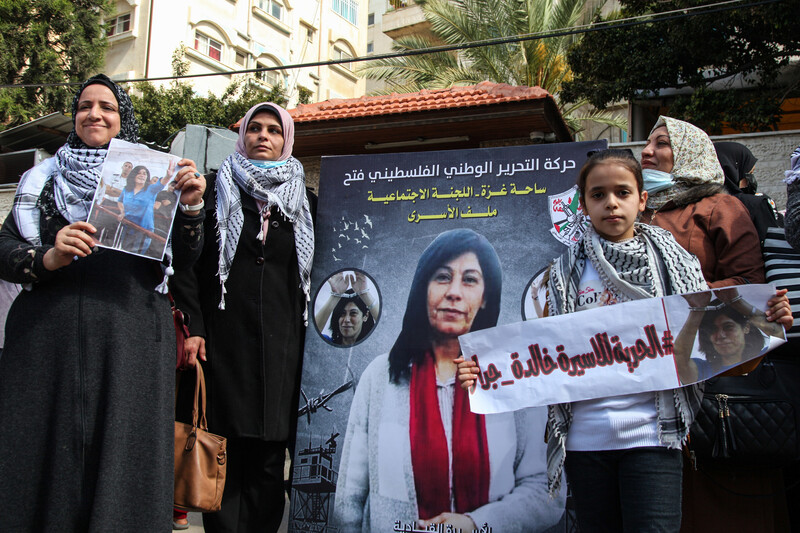
Palestinian women protest in front of the offices of the International Committee of the Red Cross in Gaza City on 8 March, which marks International Women’s Day, in solidarity with female prisoners in Israeli jails.
APA images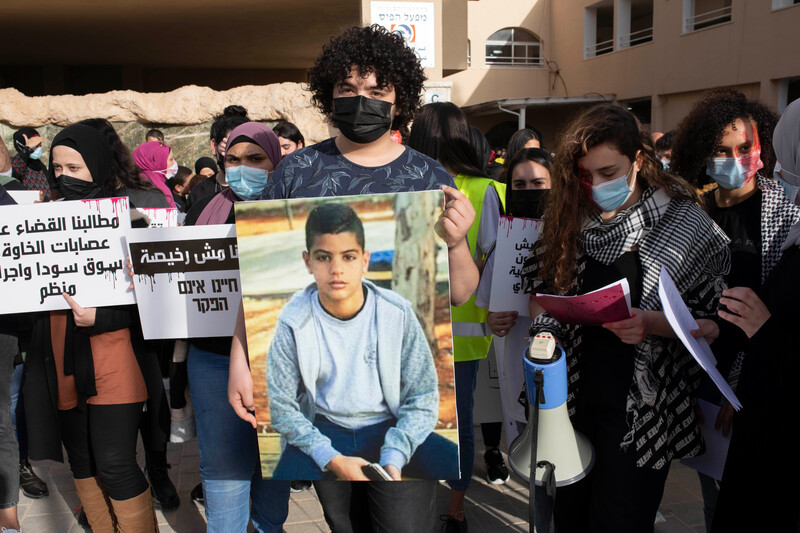
Palestinians in Israel protest the shooting death of Muhammad Ades in Jaljulia on 10 March. The 14-year-old was shot the previous night while sitting outside his home and his 12-year-old friend Mustafa Hamed, whose portrait is shown in this photo, was seriously wounded. The pair were only 100 meters from a police station when they were shot. Ades is the 23rd Palestinian citizen of Israel to die in violent circumstances so far this year.
ActiveStills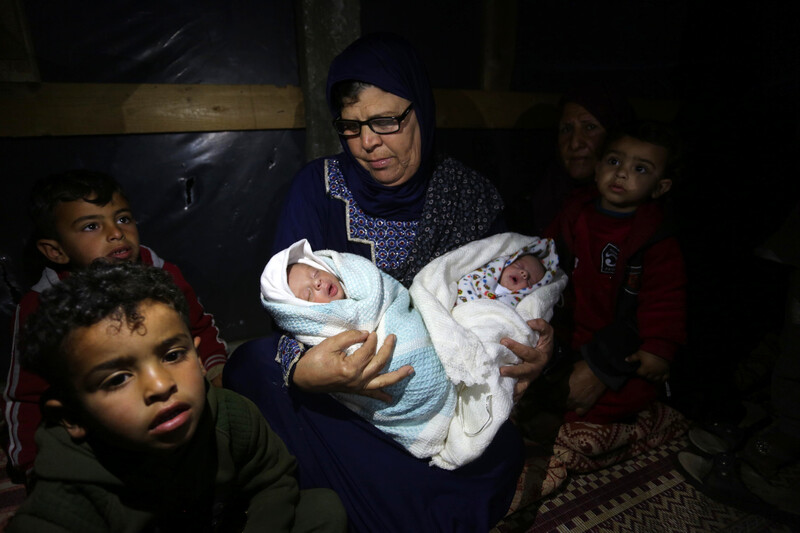
Umm Basim al-Lahham with her grandchildren in her home in Khan Younis, southern Gaza, on 12 March after two of her sons and their nephew were killed when their fishing boat exploded off Gaza’s coast.
APA images
Palestinians with Israeli citizenship march in the city of Umm al-Fahm to protest against organized crime and police violence on 12 March.
ActiveStills
Palestinians belonging to the Palestinian Federation of Industries protest in Gaza City on 13 March to demand that the Palestinian Authority, authorities in Gaza and third states provide assistance to factories and businesses in Gaza and compensate Palestinians who incurred losses due to Israeli wars and blockade.
APA images
Palestinian farmers harvest almonds in Khan Younis, southern Gaza, on 14 March.
APA images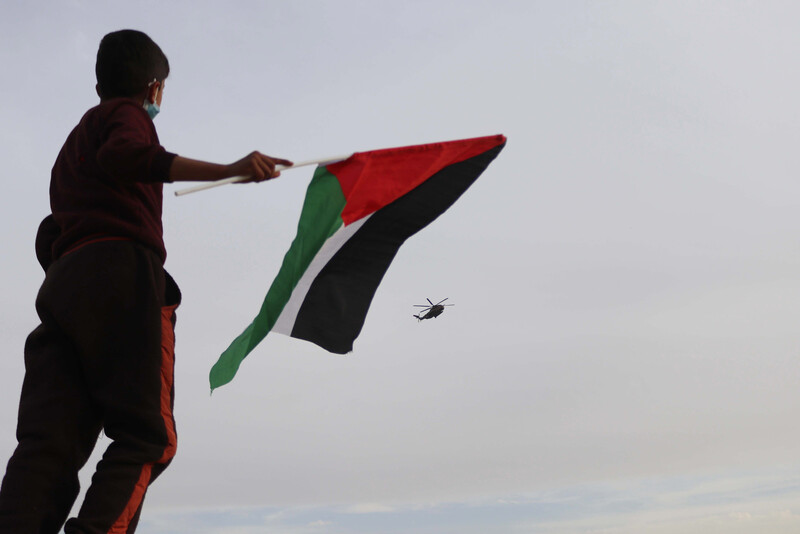
An Israeli army helicopter carrying Benjamin Netanyahu flies over Palestinians protesting against the Israeli prime minister’s visit to an archaeological site in Susiya, a Palestinian village in the West Bank on 14 March.
APA images
Five Palestinian boys, aged 8 to 13, sit in their home in the West Bank’s South Hebron Hills on 15 March. The boys had gone out to pick wild greens on 10 March when they were arrested near the Havat Ma’on settlement and held for hours under arrest in the Israeli settlement of Kiryat Arba. Israeli soldiers, who were called to the scene by settlers, violently detained the boys. After the video of the arrest went viral, the army claimed without evidence that the boys tried to steal birds from the settlement.
ActiveStills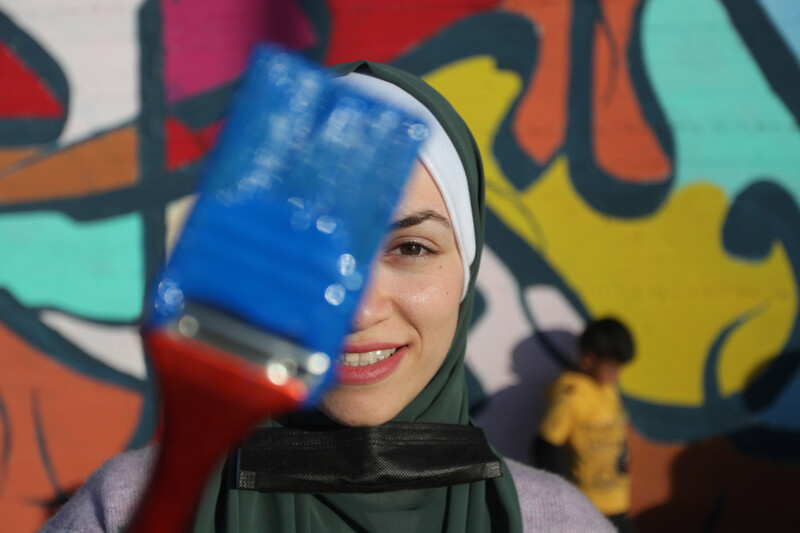
A volunteer with the Ehsan campaign team participates in the painting of the Gaza City pier on 19 March.
APA images
Palestinian women whose relatives were murdered protest against organized crime, violence and the general policies towards Palestinian citizens of Israel in Tel Aviv’s Rabin Square on 19 March.
ActiveStills
Palestinians hold a protest against the Palestinian Authority’s cuts to the stipends for the families of Palestinians killed or wounded by Israel, Gaza City, 23 March.
APA images
A Palestinian with Israeli citizenship votes during the country’s general elections in the city of Tayibe on 23 March.
ActiveStills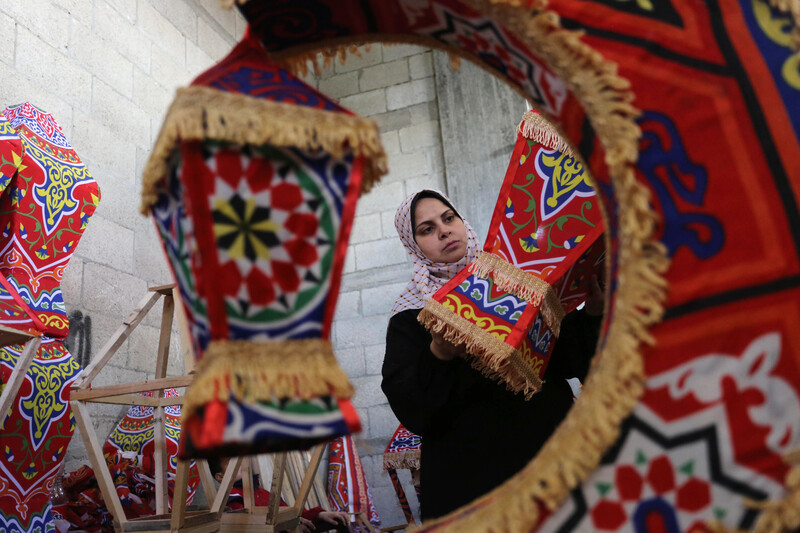
Ghadeer Zindah makes lanterns in preparation for Ramadan as part of the home business she runs with her husband to support their family of five in Khan Younis, southern Gaza, on 25 March.
APA images
Protesters march to their lands in the West Bank village of Beit Dajan on 26 March. Residents have been holding weekly protests since last fall after a new Israeli settlement outpost was erected on their land. Village resident Atef Hanaisheh was shot in the head and killed during a protest the previous week.
ActiveStills
A Palestinian man receives a COVID-19 vaccine at a Gaza City clinic run by UNRWA, the UN agency for Palestine refugees, on 27 March. Palestinian authorities had begun administering vaccines supplied under the international COVAX vaccine-sharing scheme as infections continue to rise sharply in the West Bank and Gaza.
APA images
A Palestinian worker prepares pickled vegetables in preparation for Ramadan at a factory in Khan Younis, southern Gaza, on 27 March.
APA images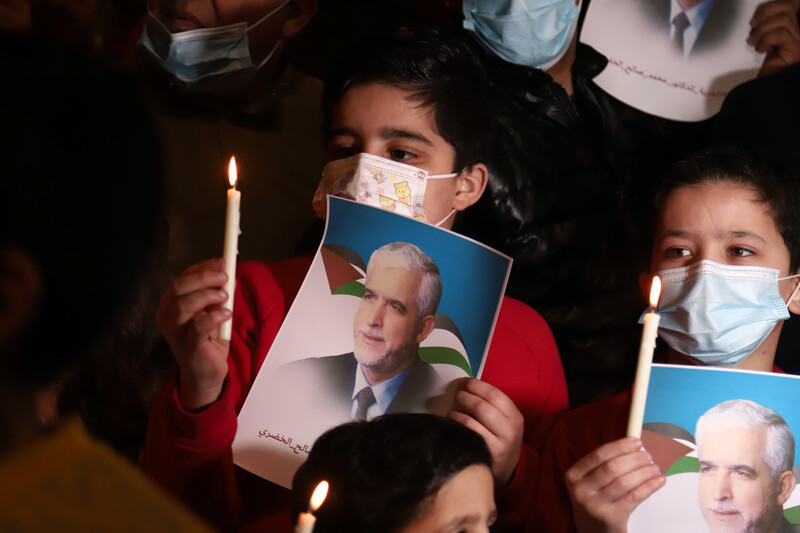
Members of the al-Khudari family light candles during a 27 March vigil in Gaza City to demand the release of Dr. Mohammad al-Khudari , 83 years old, and his son Hani, who are imprisoned in Saudi Arabia. Amnesty International warned in February that the elder al-Khudari was in urgent need of medical care. The father and son have been charged with “joining a terrorist entity,” which Amnesty says is “understood to be the Hamas de facto authorities” in Gaza. The pair’s trial “has been marred by numerous and serious violations of their due process rights,” Amnesty stated.
APA images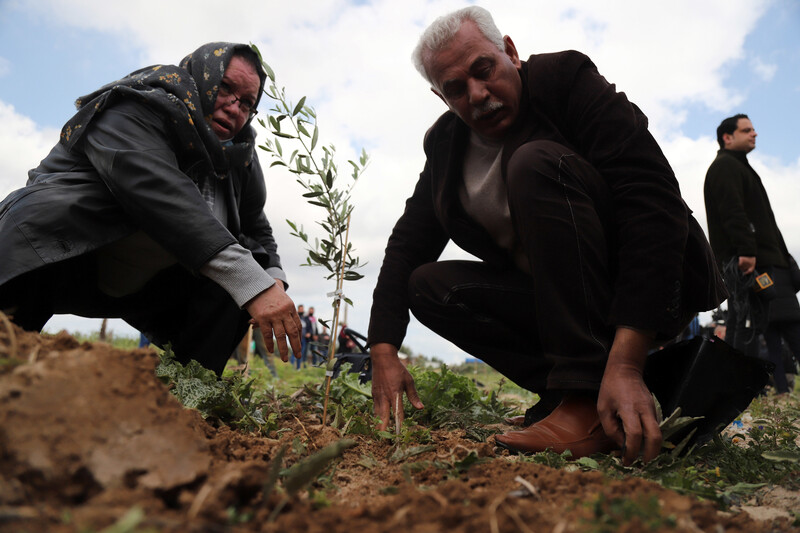
Palestinians plant an olive tree east of Gaza City near the boundary with Israel to commemorate Land Day on 30 March. Land Day commemorates six Palestinians who were killed during protests against Israeli land confiscation in the Galilee in 1976 and serves as an ongoing expression of Palestinians’ attachment to their land and determination to regain their rights.
APA images

